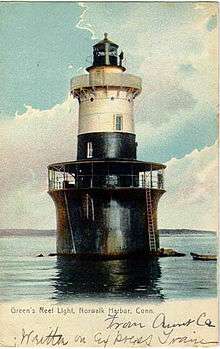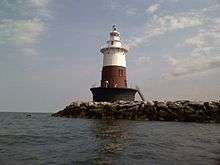Greens Ledge Light
 The light in a 1907 postcard | |
 Connecticut | |
| Location |
Norwalk Connecticut United States |
|---|---|
| Coordinates | 41°2′30″N 73°26′38.2″W / 41.04167°N 73.443944°WCoordinates: 41°2′30″N 73°26′38.2″W / 41.04167°N 73.443944°W |
| Year first constructed | 1902 |
| Automated | 1972 |
| Foundation | cast iron with concrete caisson |
| Construction | Sparkplug lighthouse |
| Tower shape | 2-stages cylindrical tower with double balcony and lantern incorporating keeper's quarter |
| Markings / pattern |
white upper half, brown on black lower half, black basement |
| Height | 52 feet (16 m) |
| Focal height | 62 feet (19 m) |
| Original lens | 5th order Fresnel lens (replaced with a 4th order) |
| Current lens | VRB-25 |
| Light source | solar power |
| Range |
white: 18 nautical miles (33 km; 21 mi) red: 15 nautical miles (28 km; 17 mi) |
| Characteristic | Al WR 12s. |
| Fog signal | 2 blasts every 20s. |
| Admiralty number | J0866 |
| ARLHS number | USA-355 |
| USCG number | |
|
Greens Ledge Lighthouse | |
| Nearest city | Rowayton, Connecticut |
| Area | less than one acre |
| Architect | Philadelphia Construction Co. |
| MPS | Operating Lighthouses in Connecticut MPS |
| NRHP Reference # | [4] |
| Added to NRHP | May 29, 1990 |
Greens Ledge Lighthouse is a sparkplug lighthouse in Connecticut, United States, off the southwest end of the Norwalk Islands, Long Island Sound, near Norwalk, Connecticut. It is on north side of the west end of Greens Ledge, west of Norwalk Harbor a mile south of the entrance to Five Mile River at Rowayton, and just over a mile southwest of Sheffield Lighthouse. Completed in 1902, it was constructed by the Philadelphia Construction Company. The light is 52 feet (16 m) tall and is made of five courses that make up its four stories. The lantern measures 7 feet (2.1 m) in diameter. The Greens Ledge Light replaced the Sheffield Island Light. Originally, the light had a fifth-order Fresnel lens, but a fourth-order Fresnel lens was installed in May 1902, just three months into its operation. Currently a VRB-25 is in use and it has alternating white and red flash every 24 seconds. The light was added to the National Register of Historic Places as Greens Ledge Lighthouse on May 29, 1990.
Design

In the 1890s, the lighthouse was first formally proposed to mark the Norwalk Harbor. In 1899, the United States Congress appropriated $60,000 for the establishment of a light and fog signal at Greens Ledge. In 1900, the Philadelphia Construction Company was contracted to construct the foundation and the superstructure. The design for this type of lighthouse was first realized in 1873, from Major Eliiot of the Lighthouse Board. The foundation form is made of identical curved-iron plates with top inward-pointing flanges that are bolted together and secured with knees. The assembled rings are lowered into the water and filled with concrete or stone, concrete for the Greens Ledge Light. A series of photographs from the work in 1901 shows the assembly of the three lower courses at Wilson's Point, the lowering of the cylinder and the light in the fall of 1901 prior to a deposit of protective riprap.[5]
The 52-foot (16 m) tall Greens Ledge Light was completed in 1902 and serves as a typical example of a sparkplug lighthouse.[3] Located in 10 feet (3.0 m) of water, the foundation flares out to support the deck the lighthouse is built on and includes a cavity for the lighthouse's brick basement and cisterns. The four-story structure of the lighthouse is assembled from five courses of curved iron plates. The interior is lined with brick to insulate and strengthen the tower and to "provid[e] an anchorage for the winding cast-iron stairs which rise on the periphery of each story," writes historian Dorothy Templeton.[5]
The plain prefabricated features underwent a period of development of which the Greens Ledge Light was part of a second phase. Templeton describes, "the brackets which support the watchroom gallery and covered deck [as having] a simplified classical detailing and [the] rectilinear window sashes are enclosed in shallower, plainer cast-iron surrounds."[5] A deck encircles the light on above the first story, the watchroom and lantern. The original roofing and some cast-iron stanchions of the decks are able to be seen atop the riprap. The cast-iron door to the lighthouse faces south and at the time of nomination the windows were sealed with plywood. The first floor of the lighthouse serves as the kitchen. The second level has two rooms split by a partition with the smaller room being a bathroom. The third level was not divided, but did not have a description in the National Historic Register of Places survey.[5] The fourth floor has six porthole windows and has had much of its woodwork removed and part of the cast-iron floor and brick wall are exposed. The lighthouse's lantern measures 7 feet (2.1 m) in diameter.[5] Once active, the Sheffield Island Light was discontinued.[6]
Service
Originally, the light had a fifth-order Fresnel lens, but a fourth-order Fresnel lens was installed in May 1902, just three months into its operation. The light characteristic was a fixed white light with a red flash every 15 seconds. In 1972, the light was automated and the Fresnel lens was replaced with a modern optic. The light continues to serve as an active aid to navigation.[7] In 1987, a FA-251 was installed before the current lens, a VRB-25 was installed.[8] The current light characteristic is an alternating white and red flash every 24 seconds.[9] The white and red flashes can be seen for 18 nautical miles and 15 nautical miles, respectably.[9]
During its service, the tower began to tilt and the keepers moved all the furniture to one side of the tower. The problem was reported to have been exacerbated following the 1938 New England hurricane.[6]
Importance

The light was added to the National Register of Historic Places as Greens Ledge Lighthouse on May 29, 1990.[5] It is listed as "significant as a typical example of a pre-fabricated cast-iron conical lighttower on a cast-iron tubular foundation."[5]
The lighthouse served as a source of inspiration for Walter DuBois Richards, an artist, for over forty years.[10] Since 1935, swimmers have been competing annually in the Arthur J. Ladrigan Swim Race, a one-mile (1.6 km) race from the lighthouse to Bayley Beach in the Rowayton section of Norwalk.[11]
List of keepers
This list includes known keepers, but excludes assistants and non-officers of the Coast Guard.[7]
| Name | Year | Reference |
|---|---|---|
| William DeLuce | 1902–1908 | [7] |
| Robert Burke | 1908–1909 | [7] |
| John Huskey | circa 1909 | [7] |
| John Kiarskon | circa 1910 | [7] |
| William T. Locke | 1910–1912 | [7] |
| William Rhodes | circa 1917 | [7] |
| George Petzolt | 1930–1932 | [7] |
| George Clark | 1939–1943 | [7] |
Sold
Green's Ledge Light House was put up for auction to the public and was sold on 9-15-2016 for $130,000 to the highest of 4 bidders.
- Sale-Lot Number:
- BOSTN116008001
- Sale Type:
- Online Auction
- City, State:
- Norwalk, CT
- Current Bid:
- 130,000 USD
- Bidders:
- 4
- Close Time:
- 09/15 03:03 PM CT (Closed)
- Time Remaining:
- Case #:
- 1-X-CT-0551
See also
- List of lighthouses in Connecticut
- List of lighthouses in the United States
- National Register of Historic Places listings in Fairfield County, Connecticut
References
- ↑ Greens Ledge Light The Lighthouse Directory. University of North Carolina at Chapel Hill. Retrieved 20 June 2016
- ↑ Light List, Volume I, Atlantic Coast, St. Croix River, Maine to Shrewsbury River, New Jersey (PDF). Light List. United States Coast Guard. 2009. p. 191.
- 1 2 "Historic Light Station Information and Photography: Connecticut". United States Coast Guard Historian's Office. 2009-08-08.
- ↑ National Park Service (2009-03-13). "National Register Information System". National Register of Historic Places. National Park Service.
- 1 2 3 4 5 6 7 Templeton, Dorothy (29 May 1990). "National Register of Historic Places nomination – Greens Ledge Light" (PDF). National Park Service. Retrieved 12 April 2014.
- 1 2 "Greens Ledge Lighthouse, CT". LighthouseFriends.com. April 11, 2014.
- 1 2 3 4 5 6 7 8 9 10 D'Entremont, Jeremy. "History of Green's Ledge Lighthouse, Norwalk, Connecticut". New England Lighthouses. Retrieved 11 April 2014.
- ↑ "Greens Ledge Light". Lighthouse Digest. Retrieved 11 April 2014.
- 1 2 "Greens Ledge Light". United States Coast Guard. Retrieved 11 April 2014.
- ↑ Coneybear, John F. (8 October 1982). "Artist Inspired By Love For Lighthouse". The Hour. Retrieved 12 April 2014.
- ↑ Fenwick, Alexandra (September 10, 2006). "A long crawl: Swimmers compete in annual Sound race". The Advocate. Stamford, CT (Stamford edition). pp. A3, A9.
External links
| Wikimedia Commons has media related to Greens Ledge Light. |
- United States Coast Guard
- Historic American Engineering Record (HAER) No. CT-175, "Green's Ledge Lighthouse, Long Island Sound, Norwalk, Fairfield County, CT", 14 photos, 9 data pages, 3 photo caption pages